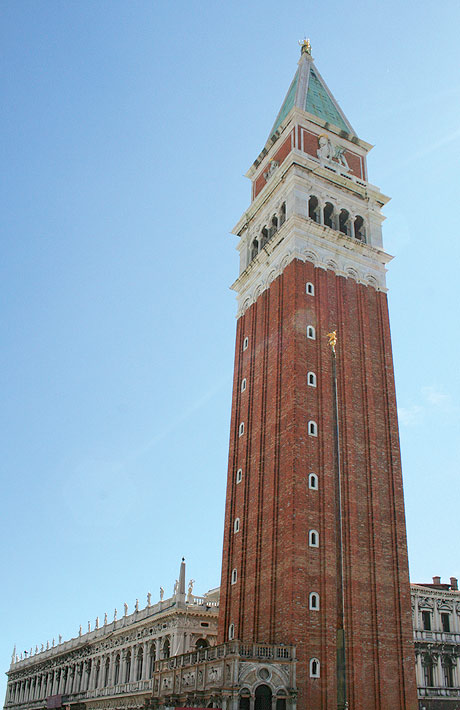Saint Mark’s Campanile

The Saint Marks’ Campanile is one of the must-visits of Venice. Located in Piazza San Marco, facing the even more reputed Saint Mark’s Basilica, the bell tower of this place of worship has ancient origins. Despite the fact most of its present structure was largely delineated in the early 16th century, between 1511 and 1514, the campanile sits on the site of a former watch tower the purpose of which was to overlook the area. The construction works at the ancient watch tower started in the 9th century, making use of the preexisting solid Roman foundations, only to be completed in the 12th century.
While the Saint Mark’s Campanile was long the model which influenced the most the building of campaniles throughout the Veneto region of Italy, its frailty was repeatedly confirmed by the numerous restoration and complete reconstruction works. It was no later than the 15th century that the original watch tower was renovated following a fire which destroyed its spire, back then made of wood. Furthermore, after a tremendous earthquake in 1511, the tower again underwent significant restoration works, but the 16th century also brought new additions to the campanile, such as the marble belfry, the gilded spire and the gilded statue of Archangel Gabriel on top of the spire (the statue served as weathervane). The paternity of these major works is attributed to Giogio Spavento, but the works proper were carried out under the careful supervision of Bartolomeo Bon. The logetta at the base of the tower was also built in the 16th century, being the chief contribution of Jacopo Sansovino to the campanile.
Sundry other significant restoration works were also carried out in the course of history, including the complete reconstruction of the campanile in the early 20th century (more precisely, between 1902 and 1912), as a result of the fact the structure simply crushed due to a crack on the lower side of the base. Even today the campanile undergoes constant restoration and maintenance, mostly because of the lack of reliability of the soil on which the base of the structure has been laid out.
Of course, the tower is also provided with bells, more precisely, five of them. The ringing of each of these bells used to have a particular meaning for the locals of Venice, but now their use is outdated (such as the fact that when the so-called Maleficio rang, it meant somebody was to be executed). Thus, the campanile was an active part of the Venetians’ life, with the usual joys and troubles, providing rhythm to their daily routine. On top of that, the tower was also used as a means of public punishment, in particular during the Middle Ages: all sorts of wrongdoers were forced into a cage suspended from the tower, such as to feel both the weather extremes (the heat or the cold, depending on the season) and the public scorn. At present, the Saint Mark’s Campanile is one of the best lookouts in Venice: people who climb to its top can admire the sweeping view of the lagoon in its entire splendor. The visits to the campanile are organized by the same authorities in charge with the Saint Mark’s Basilica.
- Name:
- Saint Marks’ Campanile (Campanile di San Marco)
- Address:
- 328, Piazza San Marco, 30124, Venice, Italy
- Telephone:
- 0039 041 2708334 / 0039 041 2413817
- Email:
- [email protected]
- Website:
- www.basilicasanmarco.it
 Saint Mark's Campanile
Saint Mark's Campanile